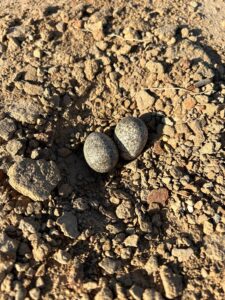
Beyond Tokenism: A Modern Approach
to Acknowledging Country with Practical Tips
Aboriginal Partnerships Manager, Den Barber recently shared his personal perspective on the practice of Acknowledgement of Country at the first Regional Landcare Coordinators Meeting under the Landcare Enabling Program. This followed on from a moving Acknowledgement performed at Murrumbateman during a visit by the Board and the Minister, the Hon. Tara Moriarty. Den emphasised that he was speaking solely for himself, recognising that each First Nations person would have their own interpretation and way to show their respects to both Country and Elders.
Distinguishing between Acknowledgements and Welcomes to Country, Den underscored the significance of the former, expressing concern that it often feels perfunctory and lacking in genuine meaning. He stressed that Acknowledgements need not be performed at every meeting and suggested that their relevance should be considered in relation to the meeting’s primary purpose.
Den proposed that organisations such as Landcare could establish guidelines for meaningful Acknowledgements. Landcare is an organisation that should be leading the way as its purpose is to protect the Country we all live and work on. This is what we do! When we protect and nourish Country, we are making sure that future generations can thrive. Whilst traditionally the host might lead the Acknowledgement, Den suggested that any attendee could do so, highlighting the importance of personal connection to the land.
He recommended incorporating specific details, such as the name of the Traditional Lands, into introductions or presentations during online meetings. Additionally, Den encouraged creative expressions of connection to Country, such as wearing Aboriginal-designed clothing or sharing personal experiences, like capturing photos of significant natural occurrences.
While advocating for creativity, Den cautioned against politicising or disrespecting Indigenous culture. He offered his support and guidance to individuals seeking to incorporate meaningful Acknowledgements into their practices, welcoming collaboration and respectful dialogue.
In a recent trip to the Central West Regional Community of Practice event held in Parkes, Den’s proclivity to watch out for artefacts was rewarded by stumbling across the pictured eggs – which are those of the Black Winged Stilt – confirmed by an angry bird, and an APP.
Given that the birds generally lay 4 – 6 eggs, it’s not surprising that he or she was extremely protective. Fox scats, and prints were present across the site, so it’s possible that some of the eggs may have been snaffled. The sighting occurred on the former sewerage ponds which had been decommissioned and turned into a wetlands area. It is now proving to be a suitable breeding habitat. Despite not yet being open to the public, large dog prints were also observed during the visit. Thanks to Marg Applebee for arranging the morning tour with our host Michael from Parkes Shire Council.

Image: Black Winged Stilt eggs